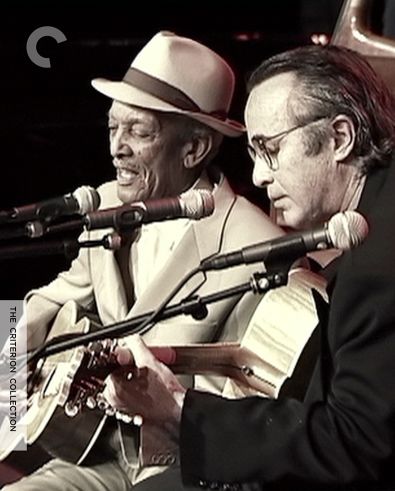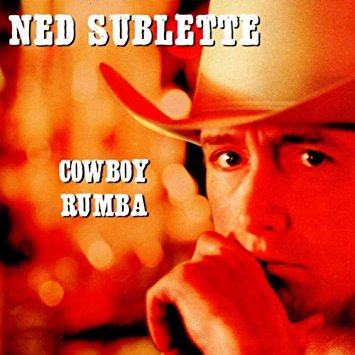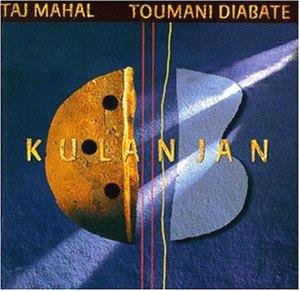Elijah Wald – Worlds of Cooder and Sublette
[Home] [Bio] [Jelly Roll Blues] [Robert Johnson] [Dave Van Ronk] [Narcocorrido] [Dylan Goes Electric] [Beatles/Pop book] [The Dozens] [Josh White] [The Blues] [Hitchhiking] [Other writing] [Musical projects] [Joseph Spence]
Two Worlds of Cooder and Sublette
by Elijah Wald
originally published in the Boston Globe
The odd and indefinite category labeled “world music” has grown by leaps and bounds over the last decade, but the most successful records in the field have all involved intermediaries, from Paul Simon going to South Africa to Ry Cooder in Cuba. These introduce new listeners to unfamiliar sounds, and yet there is often something disturbing about them. When a rock star heads off to the Third World to record with local artists, is this cultural interchange or just a musical tourist junket?
There is no one answer, of course, but two current examples are worth looking at, not only for their own merits but because of what they can say about the whole phenomenon. Both were created by Anglophone Americans recording with local musicians in the Spanish-speaking Caribbean; beyond that, they could not be more different.
One is Cooder’s “Buena Vista Social Club” (World Circuit/Nonesuch), two years old, but newly taking off due to the Wim Wenders movie of the same name, which is essentially an extended infomercial for the Cooder project. The other is Ned Sublette’s “Cowboy Rumba” (Palm Pictures). Each disc opens with a track that defines its aesthetic: The first has “Chan Chan,” a lilting duet between the Cuban masters Compay Segundo and Eliades Ochoa, behind which Cooder plays an atmospheric slide guitar part. The latter has a Dominican merengue band playing a full-throttle dance chart, over which Sublette sings “Ghost Riders in the Sky.”
The obvious way to file these projects would be as, on the one hand, a sincere homage to a classic Latin style and, on the other, a possibly tasteless joke. However, two things complicate the matter. One is that, while Cooder speaks no Spanish, spent barely a week in Cuba, and never met the “Buena Vista” musicians before recording with them, Sublette is a fluent Spanish-speaker who has spent the last decade shuttling between New York and Havana, producing Cuban groups for his Qbadisc record label. The other is that, while “Buena Vista” has sold largely to an Anglo audience hearing the music for the first time, “Ghost Riders” is having its greatest success on Latin radio.
 Cooder has done a wonderful job, acting as the catalyst for a
project that brought together some magificent, neglected musicians and
is now providing them with success beyond their wildest dreams. The
unprecedented sales of “Buena Vista,” which recently went
gold, has created a huge new audience for some of the world’s
loveliest music. Meanwhile, Sublette’s record is selling in the
hundreds, and, despite being great fun, is neither a transcendent masterpiece
nor likely to start any sort of mass trend. Nonetheless, there is a
sense in which Sublette, singing Texas country over arrangements provided
by some of the top bandleaders in the Caribbean, is attempting a genuine,
thoroughly-conceived meeting of disparate styles, while Cooder is doing
what used to be called culture-tripping -- waltzing in on a foreign
culture, sampling a bit of it, then waltzing off to sample another.
Cooder has done a wonderful job, acting as the catalyst for a
project that brought together some magificent, neglected musicians and
is now providing them with success beyond their wildest dreams. The
unprecedented sales of “Buena Vista,” which recently went
gold, has created a huge new audience for some of the world’s
loveliest music. Meanwhile, Sublette’s record is selling in the
hundreds, and, despite being great fun, is neither a transcendent masterpiece
nor likely to start any sort of mass trend. Nonetheless, there is a
sense in which Sublette, singing Texas country over arrangements provided
by some of the top bandleaders in the Caribbean, is attempting a genuine,
thoroughly-conceived meeting of disparate styles, while Cooder is doing
what used to be called culture-tripping -- waltzing in on a foreign
culture, sampling a bit of it, then waltzing off to sample another.
There is nothing wrong with this, per se. Cooder is an expert instrumentalist, whose “Chicken Skin” band of the 1970s inventively fused players from diverse backgrounds. There is no reason why he should not be able to have fun jamming with African, Indian or Cuban musicians (to name his three most recent records), or to release the result for the delectation of his fans. What can get annoying, though, is the number of people who confuse these one-off jams with genuine cross-cultural exploration or interchange, and also the sense that this approach is rather disrespectful to the other culture.
This is an issue that goes to the heart of the whole “world music” boom, and is implied by the term itself. In a sense, we are dealing with the musical equivalent of one of those medieval maps on which all the details of Europe and the Holy Land are clearly marked but the rest of the planet is full of blurred or unmarked borders, pictures of people with two heads, and warnings that “here be monsters.” In the modern record store, we have the Euro-American mainstream -- rock, jazz, classical, folk, country, hip-hop, etc., etc. -- neatly delineated and divided into subcategories, and then we have “world music,” divided only by country (or by continent) and containing all the mysterious sounds from “out there.”
 What makes this view particularly odd is that it is so different from
the way those mysterious foreigners regard us. Given a constant diet
of American films and television, the average person on the other side
of the world may be more familiar with the streets of Los Angeles --
or a Beacon Hill barroom -- than with the people living over the next
mountain range. In most places, the fusion of “world” and
Euro-American styles is the norm: Indian pop stars sing a style that
overlaps ancient court song and Madonna, Arabic bands combine shawms
and disco rhythm tracks, and Africans have been blending traditional
drums, James Brown vocals, Cuban horn sections and rock lead guitar
for so long that it is considered rather old-fashioned. As for Sublette’s
cowboy merengue, Latin listeners might consider it a novelty number,
but probably no more so than, say, Johnny Ventura’s merengue about
Lorena Bobbitt.
What makes this view particularly odd is that it is so different from
the way those mysterious foreigners regard us. Given a constant diet
of American films and television, the average person on the other side
of the world may be more familiar with the streets of Los Angeles --
or a Beacon Hill barroom -- than with the people living over the next
mountain range. In most places, the fusion of “world” and
Euro-American styles is the norm: Indian pop stars sing a style that
overlaps ancient court song and Madonna, Arabic bands combine shawms
and disco rhythm tracks, and Africans have been blending traditional
drums, James Brown vocals, Cuban horn sections and rock lead guitar
for so long that it is considered rather old-fashioned. As for Sublette’s
cowboy merengue, Latin listeners might consider it a novelty number,
but probably no more so than, say, Johnny Ventura’s merengue about
Lorena Bobbitt.
Now, the fact that these fusions are common does not mean that they are necessarily good. Indeed, many are as silly and ill-conceived as the most lackadaisical American culture trip. While I thoroughly enjoy the blend of Sublette’s Texas twang with the Cuban fire of NG La Banda, I also laugh a lot. As for third world disco, I find much of it as soulless and idiotic as “Disco Duck.” However, its listeners are approaching it very differently than Westerners tend to approach the fusions produced here. Third World listeners hear a constant barrage of undiluted Western music, and virtually no non-Euro-American artist has had the chutzpah to claim that he or she is improving or modernizing the originals.
By contrast, many Americans will hear a foreign style only through the mediation of a one-off fusion project, which may be wildly atypical and even insulting. A particularly egregious example was a recent album and tour featuring Djivan Gasparyan and Michael Brook. Gasparyan is one of the world’s master musicians, a brilliant innovator who has tranformed the Armenian duduk from a simple shepherd’s pipe into a solo instrument featured in ensembles and symphonic settings. Brook is an electric guitarist who specializes in ambient wallpaper music. So here was Brook’s band, which could barely navigate Armenian rhythms, backing the first local visit by Gasparyan and surrounding his music with new age arrangements created without Gasparyan’s input, a process that Brook defended by saying, with unintended irony, that Gasparyan was “entitled, and in fact obligated, to develop his work.”
Similar claims are regularly being made by Western musicians and producers who enjoy monkeying around with foreign styles. The number of African artists, for example, whose music has been “improved” by French, English or, more rarely, American rockers is too long to even begin listing here.
It is not that traditions must be maintained immaculate and unchanging. Exciting as it is that so many ancient styles remain strong and alive, there is no more reason for a young Turk to play ancient Turkish music than for Puff Daddy to sing blues or Bob Dylan to play klezmer. Indeed, one reason that some Cuban music fans have mixed feelings about Cooder’s project is that it ignores virtually all the developments Cuban music has undergone in the last five decades.
The problem, once again, is one of respect. On “Buena Vista,” whether one likes or dislikes Cooder’s contribution, one never gets the feeling that he is playing what the Cubans have asked him to play. They are doing what he asks, and he is doing what he feels like. Why, over and over again, do Western artists who would never presume to go into a studio with a famous string quartet for an afternoon and come up with a cool lead to play over Beethoven, or to put a trendy rock background under a Pavarotti aria, think that it is more appropriate to do this to a tradition that is even farther from their background and knowledge?
Respectful fusions are not impossible, by any means, but they take time and a willingness to accept that the other players might have a better idea of how things should go. One model was provided by the mixing of jazz and Cuban music in the 1940s. Jazz horn players like Dizzy Gillespie teamed up with Cuban rhythm sections, both in Cuban and jazz bands. Playing together, and trading off control of the process, both camps learned, adapted, and benefitted in ways that still resonate in both styles.
In part, this was because each was providing something that the other needed. The jazzmen were more advanced harmonically and in their lead chops; the Cubans were more advanced rhythmically. In a quite different situation, the Kronos Quartet has comissioned collaborative works by various musicians from around the world, expanding its own repertoire while providing its redoubtable services to the foreign composers.
What matters is the feeling that the collaborators are more or less equally matched, both in their aims and the extent to which they control the result. Two recent examples leap to mind. “Genghis Blues” (TuvaMuch), an offshoot of the film of the same name (currently at the Brattle Theatre) documents the most far-fetched musical meeting possible: a blues singer, Paul Pena, interacting with Kongar-ol Ondar, a master of the throat-singing style of the Siberian region of Tuva. What makes this work is that Pena spent ten years learning throat singing and the Tuvan language, and figuring out how to meld it with blues. The result is a truly weird record, not to everyone’s taste, but unquestionably interesting and a genuine meeting of equals from very different worlds.
 Then there is the Taj Mahal-Toumani Diabate album, “Kulanjan”
(Hannibal). An extended exploration of the overlap between the West
African and African-American traditions, it sounds completely natural.
In concert, as part of Africa Fete at the Hatch Shell, Mahal wore Malian
robes, spoke with the band and audience in French, and fitted into the
group as simply one among several great players and singers. The music
never sounds like Mahal’s “thing” imposed on or fitted
into a Malian framework, but rather like a cohesive whole -- in this
case, something of a family reunion.
Then there is the Taj Mahal-Toumani Diabate album, “Kulanjan”
(Hannibal). An extended exploration of the overlap between the West
African and African-American traditions, it sounds completely natural.
In concert, as part of Africa Fete at the Hatch Shell, Mahal wore Malian
robes, spoke with the band and audience in French, and fitted into the
group as simply one among several great players and singers. The music
never sounds like Mahal’s “thing” imposed on or fitted
into a Malian framework, but rather like a cohesive whole -- in this
case, something of a family reunion.
Mahal had a band with Cooder when both were starting out, and he took part in Cooder’s album with the Malian guitarist Ali Farka Toure. The two have diverged over the years, however, and one cannot help connecting the dots when, speaking by phone from a tour stop with his Malian group, Mahal sardonically sums up an attitude that he has found irritating in other Western players: “I am so hip and well-endowed that I can just pop into any culture at will and throw something together, and because of my name and recognition in this sort of material space, it can be thrown out there to throw the light on it.”
Mahal is quick to add that a lot of people need a guide or intermediary before they can hear a foreign style: “They could be standing next to it, listening to it happen, and if they don’t know what it is, they don’t have their internal receptors turned on. But if it comes through something where they are told that this is where it should be at, then they can get there.”
Cooder certainly has accomplished this with “Buena Vista.” Many of the artists on that album are now touring on their own, and a show at Symphony Hall featuring Ibrahim Ferrer and Ruben Gonzalez sold out the day tickets went on sale to the general public. In fact, considering the generally low profile he keeps on the sessions, Cooder might be better thought of as a presenter than a musical collaborator, and has done his work superbly.
Still, if one discounts Cooder’s musical contribution, “Buena
Vista” is only one of many fine albums of classic Cuban styles
(indeed, its success has brought on a flood of releases of similar quality).
It is no Dizzy Gillespie with Machito, or a Paul Simon with Ladysmith
Black Mambazo. Of course, Sublette’s “Ghost Riders in the
Sky” is not on that order either, but it certainly is unique,
and it will get a lot more Latinos out on the dance floor.
© 1999 Elijah Wald